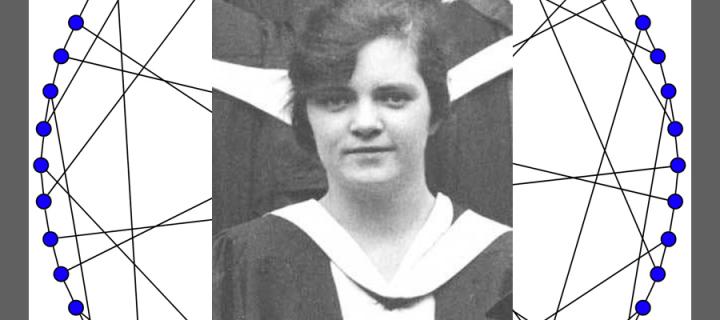Marion Cameron Gray (1902-1979)
Scottish mathematician who discovered the first graph with 54 vertices and 81 edges while working at American Telephone and Telegraph. The innovative and useful graph is commonly known as the Gray graph.

Early life and education
Marion Gray was born in Ayr in 1902 to Marion (née Cameron) and James Gray, and attended Ayr Grammar School (1907–1913) and Ayr Academy (1913–1919). In 1919 she enrolled at the University of Edinburgh where she graduated top in 1922 with a first class honours in Mathematics and Natural Philosophy. She continued on at the University for a further two years as a post-doctoral student of Mathematics, and joined the Edinburgh Mathematical Society where she presented several of her papers including the noted 'The equation of telegraphy' and 'The equation of conduction of heat'. She was also elected to the Committee of the Society in November 1923 and continued as a member throughout her career.
In 1924 Marion travelled to the United States of America with the assistance of both a British Graduates Scholarship and a Carnegie Scholarship to attend Bryn Mawr College, Pennsylvania from where she gained a PhD. Her research topic was 'A boundary value problem of ordinary self-adjoint differential equations with singularities'.
After receiving her doctorate, Marion returned to Edinburgh to take on the post of University Assistant in Natural Philosophy at the University. She held the post for one year before going to London where she was an assistant in Mathematics at Imperial College for three years.
Employment and the Gray graph
In 1930 she was appointed to the post of assistant engineer at the Department of Development and Research of the American Telephone and Telegraph Company in New York. While working there she discovered an unusual cubic semi-symmetric graph with 54 vertices and three edges exiting each vertex, formed as the incidence graph of the 27 points and 27 lines in a 3 × 3 × 3 three-dimensional grid. It has since been demonstrated to be the smallest possible cubic semi-symmetric graph. Thinking it was a theoretical discovery without practical application, Marion did not publish her findings. Thirty-six years later, computer scientist I. Z. Bouwer rediscovered and described the graph and explained how it could answer questions regarding types of symmetry. The graph is now commonly known as the Gray graph, and similar graphs are now crucial in network theory.
In 1934, Marion joined Bell Telephone Laboratories and remained with the company for a further 30 years until her retirement.
As well as her own research articles, she compiled many reviews of publications on Mathematical Physics and served on the US Government-related committee which produced the Handbook of Mathematical Functions. She also remained an active member of various professional mathematical societies throughout her career.
Later life
After her retirement in 1967 Marion moved back to Edinburgh where she died in 1979 aged 77 years.

